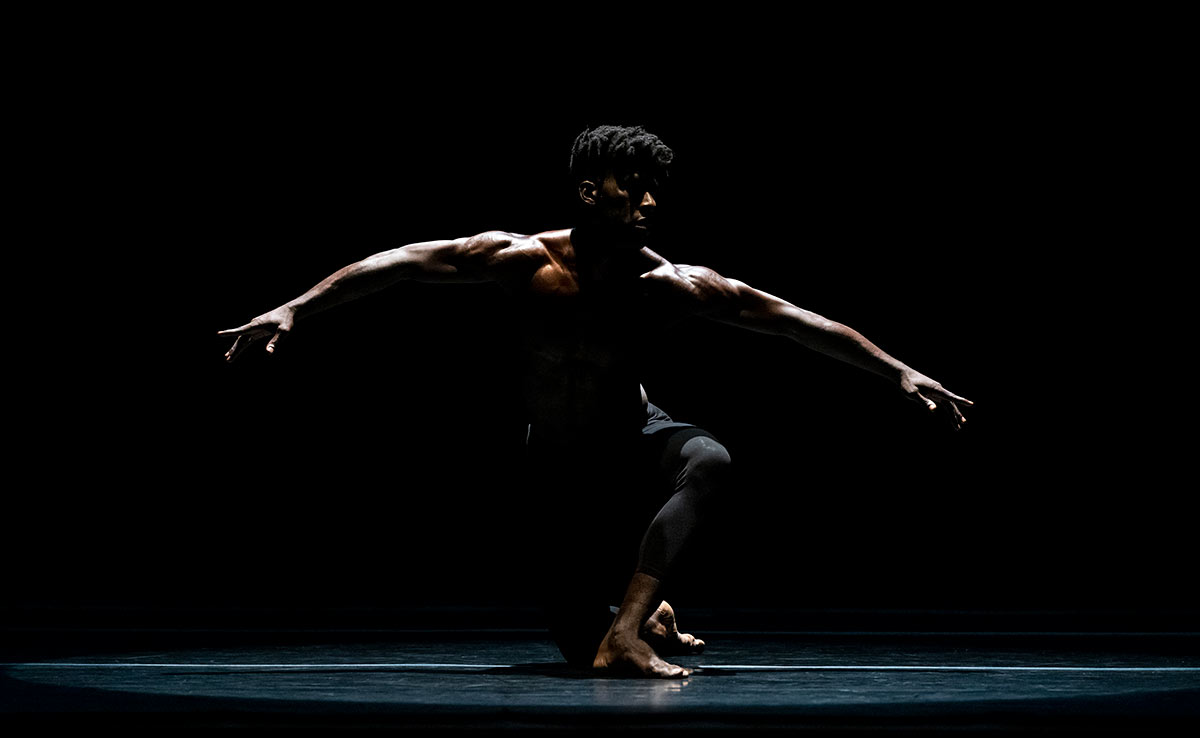
© Art Davidson. (Click image for larger version)
Molissa Fenley
State of Darkness – performed by Lloyd Knight
★★★★★
New York, Joyce Theater
19 June 2021
www.molissafenley.com
www.joyce.org
Journey to the End of the Night
Last October, The Joyce Theater broadcast a week of performances of Molissa Fenley’s 1988 solo State of Darkness through its digital platform. Each show featured a different, extraordinary dancer: the Martha Graham Dance Company’s Lloyd Knight, New York City Ballet’s Sara Mearns, the former Paul Taylor dancer Michael Trusnovec, and others. Several times I started watching these videos. And each time, even though I could tell it was a tour de force of stamina and intensity, I lost focus, my attention wandered. I found myself fast-forwarding and, in the end, giving up.
What a difference eight months make! Thanks to the vaccines, live, in-person performances are becoming possible again. Mostly outdoors, but in a few, precious cases indoors as well. Last week The Joyce opened its doors to a reduced audience for the first time since last March, for a short run State of Darkness, performed on different days by the same extraordinary lineup. I caught Lloyd Knight’s performance on Saturday afternoon. It was one of the most riveting things I’ve seen in a long time.
The 35-minute dance is set to Stravinsky’s Rite of Spring, in a reduced orchestration from 1984 by the conductor and composer Jonathan McPhee, which has a leaner sound than the original. For the duration, the dancer, in semi-darkness, lives inside the music, allowing it to animate his (or, alternately, her) movements and mind. Unlike other Rites of Spring, it is a completely internal dance, despite the virtuosity and energy required to perform its strenuous choreography. The dancer’s gaze and focus is inward, infused with sensations, emotions, and the stories inscribed in the music. Sadness, fear, serenity, conquest, desperation are all woven into the fabric of the dance.
During those 35 minutes, Lloyd Knight appeared lost to another reality as he at first gathered himself, rising onto the tips of his toes, spreading his arms like wings, revolving slowly in place. He strummed the air with one hand, like Apollo with his lyre; crouched on the floor holding out his arms like Nijinsky in L’Après Midi d’un Faune. And then he launched himself into muscular passages in which he curved his torso into concave and convex shapes, skidded across the floor on one leg, and slashed at his chest, as if to eviscerate himself. His back and shoulders, increasingly bathed in sweat, became a landscape of sinew and muscle, power and vulnerability.

© Art Davidson. (Click image for larger version)
Through it all, Knight maintained an extraordinary control; the movements never looked frayed or imprecise. His hands, even his fingers, seemed to caress the air around him, and his eyes remained awake, present. He was never just getting through it, which would have been perfectly understandable after half an hour of such strenuous effort. Toward the end, the choreography became even more expansive and demanding, with jumps, kicks, turns. The sweat flew off in rivulets. It was magnificent.
How does he do it, I kept asking myself as the performance went on. And State of Darkness is very much about this physical extreme. If Fenley hadn’t originally created the solo for herself, you might argue that the choreography is cruel, too much, too unforgiving.
But there is an undeniable amazement in watching such a performance. Afterwards, you imagine Knight collapsing into the wings and being carried off on a stretcher. And yet, there he was, just a moment later, taking a bow, drenched in sweat, smiling, very much alive. He had journeyed to the edge and back. You can’t capture that on a video.

















You must be logged in to post a comment.